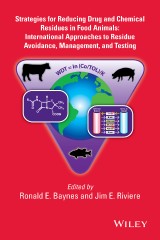Details

Strategies for Reducing Drug and Chemical Residues in Food Animals
International Approaches to Residue Avoidance, Management, and Testing1. Aufl.
|
136,99 € |
|
| Verlag: | Wiley |
| Format: | EPUB |
| Veröffentl.: | 06.08.2014 |
| ISBN/EAN: | 9781118872826 |
| Sprache: | englisch |
| Anzahl Seiten: | 336 |
DRM-geschütztes eBook, Sie benötigen z.B. Adobe Digital Editions und eine Adobe ID zum Lesen.
Beschreibungen
Highlighting international approaches; the book details strategies to minimize contamination, residue monitoring programs, and classes of drugs and chemicals that pose contaminant risk in livestock. <ul> <li>Focuses attention on drug and chemical residues in edible animal products</li> <li>Covers novel computational, statistical, and mathematical strategies for dealing with chemical exposures in food animals</li> <li>Details major drug classes used in food animal production and their residue risks</li> <li>Highlights efforts at harmonizing and the differences among areas like US, EU, Canada, Australia, South America, China, and Asia, where the issue of chemical exposures has significant impact on livestock products</li> <li>Ties veterinary clinical practice and the use of these drugs in food animals with regulatory standards and mitigation practices</li> </ul>
<p>Preface vii</p> <p>Contributors ix</p> <p>1 Importance of Veterinary Drug Residues 1<br /><i>Ronald E. Baynes and Jim E. Riviere</i></p> <p>2 Pharmacokinetic Principles for Understanding Drug Depletion as a Basis for Determination of Withdrawal Periods for Animal Drugs 9<br /><i>Sanja Modric</i></p> <p>3 Evaluation of Drug Residue Depletion in the Edible Products of Food-Producing Animals for Establishing Withdrawal Periods and Milk Discard Times 35<br /><i>Dong Yan</i></p> <p>4 Establishing Maximum Residue Limits in Europe 49<br /><i>Kornelia Grein and Isaura Duarte</i></p> <p>5 Methods to Derive Withdrawal Periods in the European Union 65<br /><i>G. Johan Schefferlie and Stefan Scheid</i></p> <p>6 Population Pharmacokinetic Modeling to Predict Withdrawal Times 81<br /><i>Sharon E. Mason</i></p> <p>7 Physiologically Based Pharmacokinetic Modeling 95<br /><i>Jennifer Buur</i></p> <p>8 Residue Avoidance in Beef Cattle Production Systems 115<br /><i>Virginia Fajt and Dee Griffin</i></p> <p>9 Residue Avoidance in Dairy Cattle Production Systems 137<br /><i>Geof Smith</i></p> <p>10 Residue Avoidance in Aquaculture Production Systems 161<br /><i>Renate Reimschuessel</i></p> <p>11 Residue Avoidance in Small Ruminant Production Systems 193<br /><i>Kevin Anderson and Reha Azizoglu</i></p> <p>12 Residue Avoidance in Swine Production Systems 221<br /><i>Ronald E. Baynes and Glen Almond</i></p> <p>13 Confirmatory Methods for Veterinary Drugs and Chemical Contaminants in Livestock Commodities 233<br /><i>Hui Li</i></p> <p>14 The Food Animal Residue Avoidance Databank: An Example of Risk Management of Veterinary Drug Residues 289<br /><i>Thomas W. Vickroy, Ronald E. Baynes, Lisa Tell and Jim E. Riviere</i></p> <p>15 Risk Management of Chemical Contaminants in Livestock 303<br /><i>Ronald E. Baynes and Jim E. Riviere</i></p> <p>Index 313</p>
<p>“This book is an excellent resource for those interested in an overview of drug residue issues across multiple species.” (<i>Journal of the American Veterinary Medical Association</i>, 15 March 2015)</p> <p> </p>
<p><b>Ronald Baynes</b> is a Professor of Pharmacology and Director of the Center of Chemical Toxicology Research and Pharmacokinetics at the College of Veterinary Medicine at North Carolina State University and Fellow, American Academy of Veterinary Pharmacology and Therapeutics He has consulted for the National Institute of Environmental Health Sciences, the US Environmental and Protection Agency, and National Institute of Occupational Safety and Health on chemical exposure-related topics.</p> <p><b><br /> Jim Riviere</b> is The MacDonald Chair in Veterinary Medicine and University Distinguished Professor at Kansas State University. He is an elected member of the Institute of Medicine of the National Academies, serves on its Food and Nutrition Board, and is a fellow of the Academy of Toxicological Sciences.</p>
<p>This book presents strategies to reduce drug and chemical residues in food from livestock production, and also some of the newer technologies and theories that will shape drug residues management in the future. One of the novel features of this book is that it ties in the realities of veterinary clinical practice and use of these drugs in food animals with regulatory standards and mitigation practices. Highlighting approaches from around the world, the book details strategies to minimize contamination, residue monitoring programs, and classes of drugs and chemicals that pose contaminant risk in livestock. <br /><br />The first section focuses on strategies that are part of public policy in national and international agencies and how these agencies assess the toxicology of veterinary drugs and contaminants. These chapters provide a general introduction to basic pharmacokinetic principles pertaining to estimating a safe withdrawal time for veterinary drugs and contaminants. <br /><br />The second half focuses on the use of major drug classes in livestock food animal production systems and those drugs most likely targeted for regulatory policy, pharmacokinetic modelling, and chemical residue monitoring.</p>


















